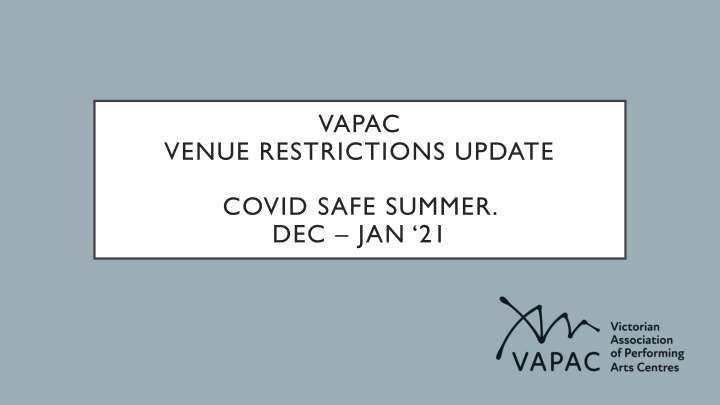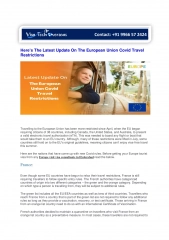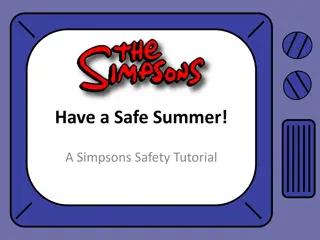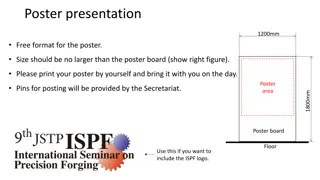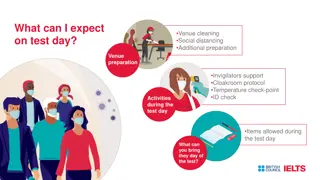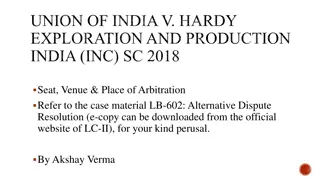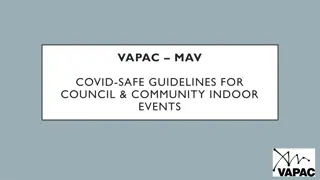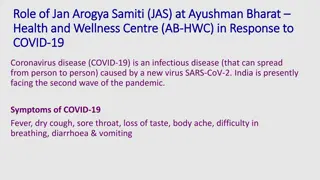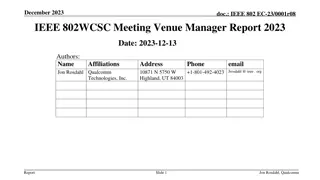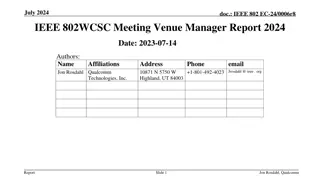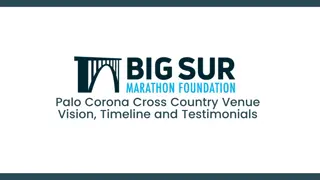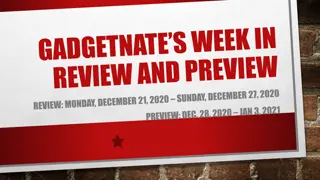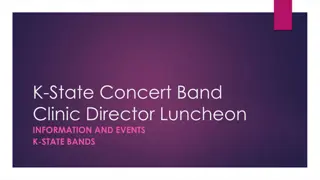Update on Venue Restrictions for COVID Safe Summer Events Dec-Jan 21
Seated and non-seated indoor and outdoor venues can open with limited capacity and must adhere to density requirements. Entry and egress must be monitored, and dancefloors can return with restrictions. Schools hosting events outside school hours have certain exemptions from restrictions.
Download Presentation

Please find below an Image/Link to download the presentation.
The content on the website is provided AS IS for your information and personal use only. It may not be sold, licensed, or shared on other websites without obtaining consent from the author.If you encounter any issues during the download, it is possible that the publisher has removed the file from their server.
You are allowed to download the files provided on this website for personal or commercial use, subject to the condition that they are used lawfully. All files are the property of their respective owners.
The content on the website is provided AS IS for your information and personal use only. It may not be sold, licensed, or shared on other websites without obtaining consent from the author.
E N D
Presentation Transcript
VAPAC VENUE RESTRICTIONS UPDATE COVID SAFE SUMMER. DEC JAN 21
SEATED INDOOR AND OUTDOOR VENUES Seated entertainment venues (both indoor and outdoor) can open with up to 75 per cent of fixed seated capacity Maximum patron cap of 1000 people. ALL activities must be Ticketed A density quotient of 1 person per 2 square metres applies in non-seated venue areas such as foyers, bars, bathrooms etc when using electronic record keeping. These areas are likely to determine venue capacity. Consider ways to move some facilities/ amenities outside of venue? Venues with capacity greater than 500 patrons must publish a COVIDSafe Plan online
NON-SEATED INDOOR AND OUTDOOR VENUES Indoor Non-Seated Venues can open with up to 50 per cent of venue capacity per space Maximum patron cap of 1000 people. Subject to Density quotient for Two square metres (electronic records) Outdoor Non-Seated Venues Subject to the Density quotient of either 2 or 4 sq metres (records.) Maximum patron cap of 1000 people is not clear say Creative Vic ALL activities must be Ticketed Venues with capacity greater than 500 patrons must publish a COVIDSafe Plan online
COVID SAFE SUMMER - PATRONS Entry to, and egress from, a seated space or a non-seated space must be monitored and staggered,where possible, to ensure compliance with the limits that apply NO Group Booking size limitations apply; It is recommended 1.5m physical distancing is maintained where practicable. Likely not achievable if aiming for 75% capacity. Consider alt risk management. eg.Masks Seating:There are no longer spacing requirements between groups or individuals in seated entertainment venues. Venues must use all reasonable endeavours to implement relevant Government recommendations to manage public health risks arising out of the venue s operation Larger events will be determined on an individual basis under the Public Events Framework.
HOSPITALITY DANCE FLOORS Dancefloors can return with a density quotient of 1 person per 4 square metres up to a maximum of 50 people at one time, if space allows. Cafes and foyer bars can open for seated and unseated service. They must use electronic record keeping and apply the two square metre rule to ensure that customers have enough room to keep 1.5 metres between themselves and others. There are no other limits on the number of customers. Hospitality venues can have up to 25 people before the two square metre rule needs to be applied.
SCHOOLS If a venue is providing an exclusive venue for the exclusive use of a single school outside school hours at any one time for educational or school gathering purposes it is NOT required to comply with the following restriction requirements : 75% limitation 1000 person limitation Density quotient in non-seated spaces Staggered entry and egress Dance floor limitations Note: a facility is not operated for the purpose of providing an exclusive venue for the exclusive use of a single school for educational or school gathering purposes if family and friends of students and staff are permitted to attend.
MASKS https://www.coronavirus.vic.gov.au/face-masks Face masks are only mandatory on public transport, taxis or ride share vehicles + inside shopping centres and large retail stores - department stores, hardware stores or supermarkets etc However: People must carry a mask at all times It is strongly recommended that you wear a face mask in other situations when you are unable to stay more than 1.5 metres from other people, such as busy walkways, and shops. In venues at 75% capacity patrons would nearly always fall into the category of unable to stay more than 1.5m apart ; so wearing a mask should therefore be strongly considered. If venues wish to maximise capacity to the 75% limit, mask wearing as a ticket condition could be important as a risk mitigation strategy. Each venue has the discretion to require patrons to wear a mask, unless they have a medical exemption.
PERFORMER RESTRICTIONS No restrictions are listed regarding performers distancing. Performers are no longer required to wear masks. Includes dancers!!! But all other COVIDSafe principles should be in place However In keeping with the six COVID Safe principles, Safe Touring plans & etc, venues should consider all crew and performers continuing to wear masks during rehearsals and at all other times when BOH - If this is part of your risk mitigation and your COVIDSafe Plan. See WorkPlace
THE WORKPLACE Now at 25% of workforce per site From January 11 private sector moves to 50% per site Unless you re one of those people nominated by your employer, you will need to keep working from home. Face coverings requirement An employer must take reasonable steps to ensure the worker, when working at a Work Premises: (a) carries a face covering at all times (excepting medical exemptions); and (b) wears a face covering where required to do so in accordance with any other Directions currently in force.
THE WORKPLACE MASKS Masks for Workers:As part of the six COVIDSafe Principles, it is recommended that all employees wear a mask; however, it is not required. If your existing COVIDSafe Plans mandates masks for workers, then workers will need to wear masks until the plan is changed. At a minimum, it is recommended that staff wear masks when social distancing cannot be maintained. (eg.Audience facing FOH staff) Employers may wish to consider different settings for FOH and BOH staff Venues can determine settings based on risk mitigation and COVIDSafe Plan
WORKFORCE BUBBLES https://www.coronavirus.vic.gov.au/creating-a-covidsafe-workplace Yes, Work Safe Bubbles still apply as one of the six COVIDSafe Principles. Workforce bubbles limit the number of workers who come into contact with each other, by putting employees into groups and keeping those groups separate. Keep groups of workers rostered on the same shifts at a single worksite and ensure there is no overlap of workers during shift changes If it is not practicable to limit a worker to only one work site, or if the worker has multiple employers, then the worker must declare this to their employer(s).The employer(s) must maintain a record of all workers who work across multiple work premises. Unless working in care facilities, there is no requirement for workers to reduce work across work sites during COVIDSafe Summer. If someone is working for more than one employer, it is recommended that the worker keep a written record of each work premises they attend to assist with contact tracing for 28 days from attending the work premises. https://www.coronavirus.vic.gov.au/general-business-faqs-victoria
RECORD KEEPING https://www.coronavirus.vic.gov.au/victorian-government-qr-code-service You must keep a record of all contact details, and the date and time at which the person attended the facility, and: Where the patrons spend most of their time in a single space (i.e. a theatre), a record of the space used should also be kept. Having the ticket holder details only is no longer adequate. The record keeping requirement applies to all persons attending a facility or venue for longer than 15 minutes, which may include staff, patrons, children, performers & crew, maintenance and delivery workers. Records kept for 28 days. QR Code & Electronic Registration Systems ensure Density Quotient of 1 : 2m2. Otherwise 1 : 4m2 Software Options see Spreadsheet of popular venue options Discussion Board
GOVT GUIDELINES The updated Industry Restart Guidelines - Indoor Entertainment Venues - still not available: soon . Outdoor Entertainment, Attractions and Experiences document is available. https://www.coronavirus.vic.gov.au/coronavirus-sector-guidance- arts-and-recreation-services The FAQ for our sector has not been updated yet, and neither have the Creative Vic Q&As Fortunately, the VAPAC Guidelines have!
PUBLIC EVENT FRAMEWORK - UPDATED When an entertainment facility hosts an activity which fulfils the definition of a one-off public event, organisers may apply for their activity to be considered under the Public Events Framework (PEF). Examples include an exhibition, festival, fair, parade, or performance. However: Most routine, ordinary, day to day operations of a venue or facility including Indoor and Outdoor are expected to remain subject to the requirements of the published directions for those activities, not the PEF. A public event is not: a private or public gathering of members of the public in a facility, venue, indoor space or outdoor space for ordinary, day-to-day operations, use, activities or services https://www.coronavirus.vic.gov.au/public-events- information-for-organisers
Public Event Framework - TIERS The Public Events Framework applies to events in three categories: 1. Tier 1: highly complex and involving more than 5,000 attendees 2. Tier 2:moderately complex involving 1,000-5,000 attendees 3. Tier 3 low complexity and involving 1,000 attendees or less * Tier 1 and 2 public events are required to submit a COVIDSafe Event Plan for review and approval by the Victorian government. DJPR and DHHS / CHO Tier 3 events; self-evaluate; published guidelines. Develop and upload a COVIDSafe Event Checklist. Need to publish online. Implement.
Public Event Framework VENUES Venues that host multiple similar events and want to operate at numbers above what is permitted in the Restricted Activity Directions, can submit one COVIDSafe Event Plan for government assessment (e.g. theatres, convention centres, sporting and racing venues). Venues do not need to submit a COVIDSafe Event Plan for each individual event or show. These plans will need to be detailed enough to cover all the different shows or events that happen within your venue. However, you will need to submit a new plan if your venue is operating a different type of one-off event or if you would like to increase your capacity limit. It is at the discretion of the venue or the event organiser who should submit the COVIDSafe Event Plan. However, a COVIDSafe Event Plan must be approved before you host your event. It is best to work together to develop a plan. If you are an event organiser, check with your venue to see if they already have an agreed plan in place before you start.
Public Event Framework - PROCESS On Line Registration and Assessment Process https://www.coronavirus.vic.gov.au/public-events 1. Tier 1 events should be registered 8 to 10 weeks before event start date. 2. Tier 2 events should be registered 4 to 6 weeks before the event start date. 3. Tier 3 events should be registered 1 week before the event. Other risk factors may mean that an event is classified at a higher tier and will require approval If a Tier 2 event has six or more of the risk factors it will be re-categorised as a Tier 1 event
Public Event Framework RISK FACTORS 1. Is the event primarily held indoors? 2. Does the event promote attendees to stand and roam around the venue? 3. Is alcohol served at the event? 4. Is there extensive singing, chanting, cheering or exhaling during the event? 5. Is there close physical interaction between attendees and/or participants where they may not be able to maintain 1.5 metres distance for short periods of time? 6. Is the event held over multiple successive days with different attendees each day? 7. Will the event include participants or attendees from interstate?
Public Event Framework PHASES Gradual easing of restrictions on a 14 day basis, each Phase. Phase 1 Now. 75% of the venue s seating capacity, up to 5,000 people seated. Density quotient of one person per two square metres applies to non-fixed seated areas e.g. grassed areas. QR Codes required Allocated seated events only. Free-standing events not permitted. Phase 2 75% of the venue s seating capacity, up to 25,000 people seated. Density quotient of one person per two square metres applies to non-fixed seated areas e.g. grassed areas. QR Codes required Allocated seated events only. Free-standing events not permitted. Phase 3 up to 100%. Possibly by Late January. Gradual return of free standing events roaming, outdoors.
COVIDSafe Plan All operations are subject to having a COVIDSafe Plan The Six COVIDSafe Principles apply 1. Ensure Physical Distancing 2. Masks all workers, patrons, performers unless a lawful exemption 3. Good hygiene cleaning 4. Record Keeping contact tracing act quickly process 5. Avoid enclosed spaces 6. Create workforce bubbles 7. The VAPAC COVID Safe Plan Template V 4.1 has been re- structured to be aligned with the COVID Safe Principles & templates
WHATS NEXT? COVIDSafe Summer restriction levels are expected to remain at current settings until end of January All subject to review based on public health advice. VAPAC Safe Guide to Re-Opening Performing Arts Centres v.4.0 is now available on the VAPAC Resources page: https://vapac.org.au/resource_category/covid-19/
